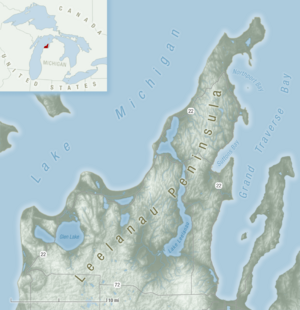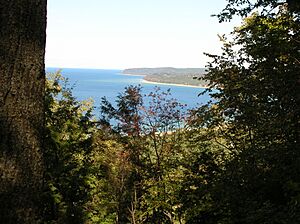Leelanau County, Michigan facts for kids
Quick facts for kids
Leelanau County
|
|||
|---|---|---|---|
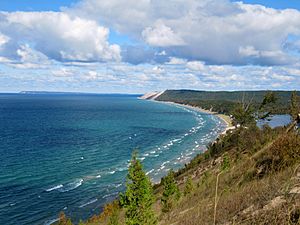
|
|||
|
|||
| Nickname(s):
"Michigan's Little Finger"
|
|||
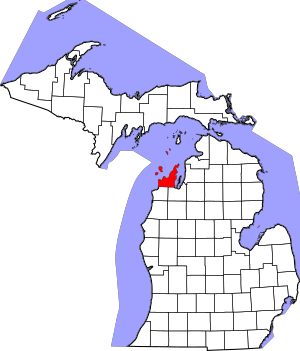
Location within the U.S. state of Michigan
|
|||
 Michigan's location within the U.S. |
|||
| Country | |||
| State | |||
| Founded | 1840 (created) 1863 (organized) |
||
| Named for | Leelanau Peninsula | ||
| Seat | Suttons Bay Township | ||
| Largest settlement | Greilickville Suttons Bay (incorporated) |
||
| Area | |||
| • Total | 2,532 sq mi (6,560 km2) | ||
| • Land | 347 sq mi (900 km2) | ||
| • Water | 2,185 sq mi (5,660 km2) 86%% | ||
| Population
(2020)
|
|||
| • Total | 22,301 | ||
| • Estimate
(2023)
|
23,019 |
||
| • Density | 63/sq mi (24/km2) | ||
| Time zone | UTC−5 (Eastern) | ||
| • Summer (DST) | UTC−4 (EDT) | ||
| Congressional district | 1st | ||
Leelanau County (/ˈliːlənɔː/ LEE-lə-naw) is a county located in the U.S. state of Michigan. As of the 2020 census, the population was 22,301. Since 2008, the county seat has been located within Suttons Bay Township, one mile east of the unincorporated village of Lake Leelanau. Before 2008, Leelanau County's seat was Leland. Leelanau County is included in the Traverse City metropolitan area of Northern Michigan. The largest settlement in Leelanau County by population is Greilickville, itself a suburb of Traverse City.
Leelanau County is coterminous with the Leelanau Peninsula, a roughly triangular-shaped peninsula that extends about 30 miles (50 km) off of Michigan's Lower Peninsula into Lake Michigan. East of Leelanau County is Grand Traverse Bay, a bay of Lake Michigan.
In 2011, the Sleeping Bear Dunes National Lakeshore, located in the county, won the title of "Most Beautiful Place in America" in a poll by morning news show Good Morning America.
Contents
Etymology
Traditionally, the county's name was said to be a Native American word meaning "delight of life", but it is a neologism from Indian agent and ethnographer Henry Schoolcraft, who sometimes gave the name "Leelinau" to Native American women in his tales. He created many faux Indian place names in Michigan, using syllables of Ojibwe, Latin and Arabic, neglecting the fact that the Ojibwa language lacks any of the phonemes associated with the letter 'L' in English.
More recently, however, scholars have established that Leelinau was first used as a pen name by Henry's wife, Jane Johnston Schoolcraft, in writings for The Literary Voyager, a family magazine which they co-wrote in the 1820s. Jane Johnston was of Ojibwa and Scots-Irish descent, and wrote in Ojibwe and English. While her writing was not published formally in her lifetime (except as Schoolcraft appropriated it under his own name), Jane Johnston Schoolcraft has been recognized as "the first Native American literary writer, the first known Indian woman writer, the first known Indian poet, the first known poet to write poems in a Native American language, and the first known American Indian to write out traditional Indian stories. In 2008 Jane Johnston Schoolcraft was inducted into the Michigan Women's Hall of Fame.
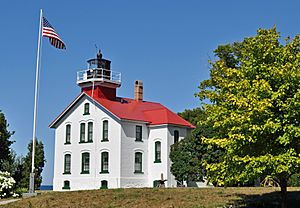

History
Leelanau County was separated as an unorganized county in 1840 by the Michigan Legislature. In 1851, it was attached the Grand Traverse County for governmental purposes, and was temporarily given the name "Leelanau Township". In 1863, Leelanau County was organized in its own right. The same year, the southern portion of Leelanau County was separated as Benzie County, and was subsequently attached to Grand Traverse County until 1869.
Sleeping Bear Dunes National Lakeshore was established in 1970, protecting much of the natural scenery of the area at the federal level.
In 2008, the county seat moved from Leland to a site in Suttons Bay Township, near the town of Lake Leelanau.
Geography
According to the U.S. Census Bureau, the county has a total area of 2,532 square miles (6,560 km2), of which 347 square miles (900 km2) is land and 2,185 square miles (5,660 km2) (86%) is water.
Leelanau County comprises the entire Leelanau Peninsula, a roughly triangular peninsula that extends about 30 miles (50 km) from the western side of the Lower Peninsula of Michigan into Lake Michigan. The peninsula forms the western shore of the Grand Traverse Bay. At its base, the peninsula is about 20 miles (30 km) wide. Leelanau County is one of a handful of counties in the United States that is entirely peninsular, a list also including Huron and Keweenaw counties elsewhere in Michigan, nearby Door County in Wisconsin, and San Francisco in California.
The county has the second-highest proportion of water area of any county in the United States, behind only Keweenaw County, Michigan. Lake Leelanau is the county's largest body of inland water, empties into Lake Michigan through the Leland River. Glen Lake, located within the boundaries of Sleeping Bear Dunes National Lakeshore, is considered one of the most beautiful lakes in the world. A substantial portion of Sleeping Bear Dunes National Lakeshore lies within the county's borders, including North Manitou and South Manitou Islands. Leelanau has been party to substantial efforts to protect itself from growth, and to foster a nature conservancy.
Extreme southeastern Leelanau County, specifically portions of Elmwood Township, are urbanized due to their proximity to Traverse City, which itself extends partially into the county. Traverse City is the largest city in Northern Michigan by population.
Adjacent counties
By land
- Grand Traverse County (southeast)
- Benzie County (southwest)
By water
- Schoolcraft County (north)
- Charlevoix County (northeast)
- Antrim County (east)
- Door County, Wisconsin (west, Central Time Zone border)
- Delta County (northwest)
Communities
Cities
- Traverse City (partially)
Villages
Charter township
- Elmwood Charter Township
Civil townships
- Bingham Township
- Centerville Township
- Cleveland Township
- Empire Township
- Glen Arbor Township
- Kasson Township
- Leelanau Township
- Leland Township
- Solon Township
- Suttons Bay Township (county seat)
Census-designated places
Unincorporated communities
- Bingham
- Burdickville
- Fouch
- Fountain Point
- Glen Haven
- Isadore
- Keswick
- Northport Point
- Peshawbestown
- Solon
Ghost towns
- Ahgosatown
- Bodus
- Crescent
- Crystal Spring
- Good Harbor
- Hatchs
- Heimforth
- Jacktown
- Kasson
- North Unity
- Onominese
- Oviatt
- Port Oneida
- Schomberg
- Waukazooville
Indian reservation
- Grand Traverse Band of Ottawa and Chippewa Indians occupies scattered areas within Suttons Bay Township.
Demographics
| Historical population | |||
|---|---|---|---|
| Census | Pop. | %± | |
| 1860 | 2,158 | — | |
| 1870 | 4,576 | 112.0% | |
| 1880 | 6,253 | 36.6% | |
| 1890 | 7,944 | 27.0% | |
| 1900 | 10,556 | 32.9% | |
| 1910 | 10,608 | 0.5% | |
| 1920 | 9,061 | −14.6% | |
| 1930 | 8,206 | −9.4% | |
| 1940 | 8,436 | 2.8% | |
| 1950 | 8,647 | 2.5% | |
| 1960 | 9,321 | 7.8% | |
| 1970 | 10,872 | 16.6% | |
| 1980 | 14,007 | 28.8% | |
| 1990 | 16,527 | 18.0% | |
| 2000 | 21,119 | 27.8% | |
| 2010 | 21,708 | 2.8% | |
| 2020 | 22,301 | 2.7% | |
| 2023 (est.) | 23,019 | 6.0% | |
| U.S. Decennial Census 2010-2018 |
|||
As of the 2000 United States census, there were 21,119 people, 8,436 households, and 6,217 families residing in the county. By the 2020 census, there were 22,301 people in the county.
Culture
There are 26 wineries on the peninsula. The Leelanau Peninsula sits astride the 45th parallel, a latitude known for growing prestigious grapes. The two Grand Traverse Bays provide the ideal maritime climate, and the rich soil does the rest. Northern Michigan specializes in growing white grapes, and is known for its Rieslings, which grow well in the summer months and late fall. The local wineries host an annual harvest fest in October. Some Riesling grapes are spared being picked in the fall, to be picked instead when they freeze, from which ice wine is made. These wineries are in the Leelanau Peninsula AVA.
Education
The Northwest Educational Services, based in Traverse City, services the students in the county along with those of Antrim, Benzie, Grand Traverse, and Kalkaska. The intermediate school district offers regional special education services, early education and English learner programs, and technical career pathways for students of its districts.
Leelanau County is served by the following regular public school districts:
- Glen Lake Community Schools
- Leland Public School District
- Northport Public School District
- Suttons Bay Public Schools
- Traverse City Area Public Schools
The county also has the following independent charter districts:
- Leelanau Montessori Public School Academy
Leelanau County has the following private schools:
- St. Mary School (Roman Catholic)
- The Leelanau School (nonsectarian, boarding)
- The Pathfinder School (nonsectarian)
Transportation
Major highways

 M-22 / LMCT is a highway that follows the shoreline of Lake Michigan. The highway enters Leelanau County from the southwest near Empire, and runs northeasterly through the communities of Glen Arbor and Leland before reaching Northport. At Northport, M-22 turns back southward, and runs through Omena, Suttons Bay, and Greilickville before exiting into Traverse City. The highway reaches its terminus at US 31/M-37 about 0.5 miles (0.80 km) southeast of the Leelanau County line.
M-22 / LMCT is a highway that follows the shoreline of Lake Michigan. The highway enters Leelanau County from the southwest near Empire, and runs northeasterly through the communities of Glen Arbor and Leland before reaching Northport. At Northport, M-22 turns back southward, and runs through Omena, Suttons Bay, and Greilickville before exiting into Traverse City. The highway reaches its terminus at US 31/M-37 about 0.5 miles (0.80 km) southeast of the Leelanau County line. M-72 is an east–west highway that follows the base of the Leelanau Peninsula. The highway begins at M-22 in Empire, and continues easterly across the southern tier of the county for about 22 miles (35 km) before reaching M-22 again in Traverse City. The highway continues southeast into Grand Traverse County, and runs across the Lower Peninsula before terminating in Harrisville, on Lake Huron.
M-72 is an east–west highway that follows the base of the Leelanau Peninsula. The highway begins at M-22 in Empire, and continues easterly across the southern tier of the county for about 22 miles (35 km) before reaching M-22 again in Traverse City. The highway continues southeast into Grand Traverse County, and runs across the Lower Peninsula before terminating in Harrisville, on Lake Huron.- M-109 is a highway in the northwestern part of the county. The highway begins at M-22 north of Empire, and continues north along the west side of Glen Lake. South of Glen Haven, the route turns east, and enters Glen Arbor, where it terminates once more at M-22.
- M-201 is a short highway in the north of the county. The route begins at M-22 south of Northport, and runs north into the village. The highway terminates immediately north of the village, and connects with various county roads that can be used to access Leelanau State Park and the Grand Traverse Light.
- M-204 is a highway that serves as an east–west connector about halfway up the peninsula. The highway begins at M-22 south of Leland, and continues east into the community of Lake Leelanau. The highway passes the Leelanau County Governmental Center before terminating once more at M-22 in Suttons Bay.
Additionally, another highway, M-209, ran from M-109 to the Coast Guard Life Saving Station in Glen Haven. Until it was decommissioned in 1995, it was Michigan's shortest highway.
Bicycle route
 USBR 35 enters Leelanau County from the southwest, and follows M-22 and M-109 up the west side of the Leelanau Peninsula. The route then turns east along M-204, then south again along M-22 in Suttons Bay. The route then follows the Leelanau Trail south into Grand Traverse County.
USBR 35 enters Leelanau County from the southwest, and follows M-22 and M-109 up the west side of the Leelanau Peninsula. The route then turns east along M-204, then south again along M-22 in Suttons Bay. The route then follows the Leelanau Trail south into Grand Traverse County.
Air service
The nearest airport with commercial service to Leelanau County is Cherry Capital Airport in Traverse City. Leelanau County is home to a number of local airstrips, including Woolsey Memorial Airport.
Notable people
- Jim Harrison – author, long-time resident of Leland Township
- Kathleen Sebelius – former Secretary of US Health and Human Services and former governor of Kansas; vacations at a summer home built by her grandfather in Leland
- The northernmost village of Northport and surrounding Leelanau Township have achieved fame as an area where the rich and famous can live quietly and anonymously. According to the Leelanau Visitors Guide: "Chef Mario Batali lives north of town at Cathead point, and comedian and actor Tim Allen routinely spent summers in Northport until his divorce. Financier Mark Spitznagel summers in Northport Point, a posh community just outside the village."
See also
 In Spanish: Condado de Leelanau para niños
In Spanish: Condado de Leelanau para niños




